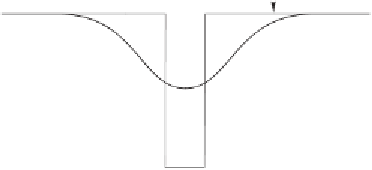Geoscience Reference
In-Depth Information
T
regional compensation
local compensation
Fig. 3.11. Local and regional compensation
Meinesz' theory, the topography is considered as a load on an unbroken but
yielding elastic crust.
In a very sloppy way which is only good for memorizing, we may say that,
standing on thin ice, Airy will break through, but under Vening Meinesz the
ice is stronger and will bend but not break.
Although Vening Meinesz' refinement of Airy's theory is more realistic, it
is more complicated and is, therefore, seldom used by geodesists because, as
we will see, any isostatic system, if consistently applied, serves for geodetic
purposes as well.
Geophysical and geodetic evidence shows that the earth is about 90% iso-
statically compensated, but it is dicult to decide, at least from gravimetric
evidence alone, which model best accounts for this compensation. Although
seismic results indicate an Airy type of compensation, in some places the
compensation seems to follow the Pratt model. Nature will never conform
toanyofthesemodelstothedegreeofprecisionwhichwehaveassumed
above. However, a well-defined and consistent mathematical formulation is
certainly a necessary prerequisite for the application of isostasy for geodetic
purposes.
For an extensive presentation of several types of isostasy, see Moritz (1990:
Chap. 8). The Vening Meinesz model has been treated in detail by Abd-
Elmotaal (1995); much information is also available in the internet. A clas-
sic on isostasy and its geophysical applications is Heiskanen and Vening
Meinesz (1958: Chaps. 5 and 7).


